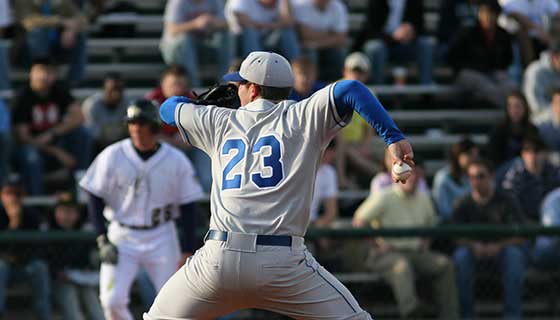Lateral Epicondylitis (Tennis Elbow)
What You Need to Know
- Tennis elbow can be caused by trauma to the elbow or more often by repeated stress on the elbow tendons such as from sports or use of certain tools.
- Symptoms of tennis elbow can include pain or weakness when grasping and aches or pain in the elbow area.
- Treatment of tennis elbow includes: activity modification, ice, medicine, stretching, braces and injections. Surgery is rarely used to treat tennis elbow.
What is tennis elbow?
Tennis elbow (lateral epicondylitis) is swelling of the tendons that bend your wrist backward away from your palm.
A tendon is a tough cord of tissue that connects muscles to bones. The tendon most likely affected in tennis elbow is called the exterior carpi radialis brevis. Tennis elbow is usually diagnosed in people between ages 30 and 50.
What causes tennis elbow?
Tennis elbow, as the name implies, is often caused by the force of the tennis racket hitting balls in the backhand position. Your forearm muscles, which attach to the outside of your elbow, may become sore from excessive strain. When making a backhand stroke in tennis, the tendons that roll over the end of your elbow can become damaged. Tennis elbow may be caused by:
-
Incorrect backhand stroke
-
Weak shoulder and wrist muscles
-
Using a tennis racket that is too tightly strung or too short
-
Other racquet sports, like racquetball or squash
-
Hitting the ball off center on the racket, or hitting heavy, wet balls
Many people who suffer from tennis elbow don't play tennis. The problem can be caused by any repetitive movement. Other causes of tennis elbow include:
-
Painting with a brush or roller
-
Working a chainsaw
-
Frequent use of other hand tools on a regular basis
-
Using repeated hand motions in various types of work. Some examples are butchers, musicians, dentists, auto workers, and carpenters.
What are the symptoms of tennis elbow?
The following are the most common symptoms of tennis elbow. You may experience symptoms differently.
At first you may have pain, burning, or an ache along the outside of your forearm and elbow. Over time, the pain gets worse. If you keep doing the activity that caused your condition, the pain may spread down to your wrist, even at rest. Pain may also persist when you place your arm and hand palm-down on a table, and then try to raise your hand against resistance. You may also feel pain when you try to lift and grip small objects, such as a coffee cup. A weak grip is another symptom of tennis elbow.
These symptoms can be caused by other health conditions. Always see your healthcare provider for a diagnosis.
How is tennis elbow diagnosed?
Your healthcare provider can often diagnosis your tennis elbow with a physical exam. In some cases, you may have certain tests, such as:
-
An X-ray. This is to look at the bones of your elbow. It is done to see if you have arthritis or other problems in your elbow.
-
An MRI. This can show your tendons and the amount of damage. An MRI of your neck can show if arthritis is in your neck, or disk problems in your spine are causing your arm pain.
-
An EMG (electromyography). This may show if you have any nerve problems in your elbow that may be causing your pain.
How is tennis elbow treated?
It’s important to not do the movement that caused your injury in the first place. Treatment may include:
-
Rest and stopping the activity that produces the symptoms
-
Ice packs to reduce inflammation
-
Strengthening and stretching exercises
-
Anti-inflammatory medicines such as ibuprofen or naproxen
-
Wrapping your elbow in a compression bandage
If these treatments don't work, your healthcare provider may talk to you about:
-
Bracing the area. This is to keep it still for a few weeks or using a special brace with activities
-
Steroid shots (injections). These help reduce swelling and pain
-
A special type of ultrasound (shock wave therapy). This can help break up scar tissue, increase blood flow, and promote healing.
-
Platelet-rich plasma (PRP). This treatment injects your own blood platelets into the affected area to promote healing
-
Surgery. This is only done in rare cases. But if symptoms don't respond to other treatment, surgery may be advised.
What can I do to prevent tennis elbow?
-
Keep your arms flexible and strong.
-
Stay away from repetitive movements.
-
Warm up before exercising or using your arms for sports or other repetitive movements.
-
If you play a racquet sport, make sure your equipment is right for you.
When should I call my healthcare provider?
Call your healthcare provider if you have any of the following:
-
Pain or trouble moving affects your daily activities
-
Pain doesn’t get better or it gets worse with treatment
-
You see a bulge or lump on your arm
Key points about tennis elbow
-
Tennis elbow is swelling or tearing of the tendons that bend your wrist backward away from your palm.
-
It’s caused by repetitive motion of the forearm muscles, which attach to the outside of your elbow. The muscles and tendons get sore from too much strain.
-
Symptoms include pain, burning, or an ache along the outside of the forearm and elbow. It may get worse and spread down to the wrist if you keep doing the activity that causes the condition. Your grip may become weak.
-
Tennis elbow can be treated with rest and medicines to help with the inflammation. Exercises often help too. In rare cases, surgery may be done to fix the tendon.
-
You can help prevent tennis elbow by doing things like warming up before exercise or sports, increasing activity slowly, using the right equipment for activities, and strengthening your arm muscles.






